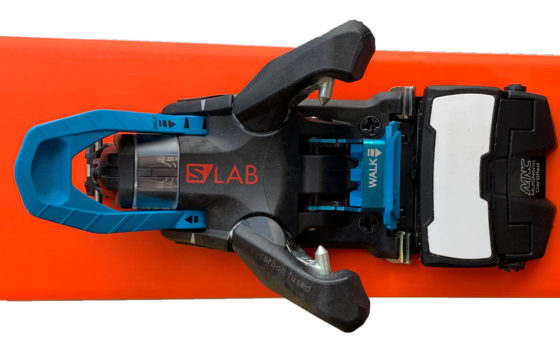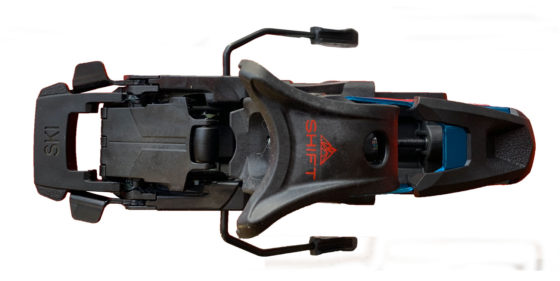In case you missed it, Salomon nailed what budding backcountry skiers want. They’ve wanted the same thing since forever, something they’re familiar with; a full alpine binding with step in convenience, brakes, DIN calibrated release, PLUS the ability to do a lap back up with skins. Plate bindings have been available to do that since the 1980s but it took the Duke for alpine skiers to “see” it. With the new Shift binding Salomon dumped the weight of the plate by putting tech pins into the wings of an alpine toe piece. Genius.
They didn’t invent that out of thin air. The concept of changing the toe was championed by CAST in the Tetons. The Shift is easier and faster. And G3’s Onyx showed that holding the pins open with your pole was easier to get into than doing the Dynafiddle dance. Shift agrees.
Downhill Gear
In downhill mode you get Salomon’s classic toe and heel connection that is easy to step in to, and has a long track record of reliable safety release. Can you say “peace of mind?” There’s a block of plastic at the toe that flips up or down, depending on what mode you want. For making turns, the block needs to be flipped up which prevents your boot from connecting with the pins, and the toe slips under the wings. Step down to lock your heel and charge the slopes. Buyer beware, the Shift only has release setting from DIN 6-13. You can charge, but you need to stick the landing if you’re in the air force.
Uphill Gear
To shift into uphill mode, flip the mode block down. This raises the boot above the AFD plate, and opens access to the pins in the side of the wings. Press the lever at the front to open the wings enough for the pins to slide into your boot inserts. Let go and the wings clamp onto your boot. Unexpectedly, this is easier to learn than aligning inserts and stepping down to latch the pins on the boot, the classic Dynafiddle way. To prevent the pins from opening up and disconnecting, lift that lever to lock out release while skinning. At the back, you flip a plate back that, again raises the height your boot rests at. This also causes the brakes to be retracted and locked in the up position.
The wings create a snow trap, so in sticky conditions you can expect to do some proactive maintenance to prevent icing. Same for the heel climbing posts. You be forewarned.
There are some limits to this binding, and they relate to the overall efficiency and functionality of the Shift in backcountry mode. On a big tour, like more than 3,000 vertical feet you might bemoan the weight; especially if you’re over 40. If you’re younger, toughen up kid. The point is, at almost two pounds per foot, these are “heavy.” Even so, it’s only drag weight, not something you’re lifting every step of the way like Salomon’s eight pound behemoth the Guardian, ugh, may it rest in peace.
Secondly, the lack of a flat touring mode could be annoying if you have a long approach. 2° isn’t bad, but it isn’t flat either. For steeper skin tracks, an additional climbing post lifts you to 10°. This is a bit shy of the more common 12°–13° climbing pegs, but still useable. Who knows, it might help moderate the “normal” pitch on the classic American skin track.
‘UGE Boot Compatibility
Thanks to an adjustable height AFD pad, these bindings work with almost any boot for downhill as long as it has a classic alpine DIN toe shape. Whether you’re wearing Dynafit Hoji Free boots, or a classic alpine boot without lugged soles, and of course, WTR, Grip-Walk, etc., the Shift will hold on tight and only let go when it should thanks to DIN calibrated release settings should you lose control. Theoretically.
Matching Boots, Bindings & Goals
The key to Shift’s appeal is the number of options there are for high performance alpine boots with tour ready tech inserts. Every alpine boot maker now makes a version of their race boot with tech inserts and a cuff that allows walking mobility. Find one that fits and drives a ski the way you want it to ride and you’ll want the tightest connection available. Shift delivers that plus 2-pin touring that is as efficient as you can be without battery assist.;)
Salomon
Shift
MSRP: $600
Weight/binding: 26 oz / 1 lb., 11 oz. • 738 g
Release Values: DIN 6-13
Brake widths available: 90, 100, 110, 120mm
© 2019




Recent Comments